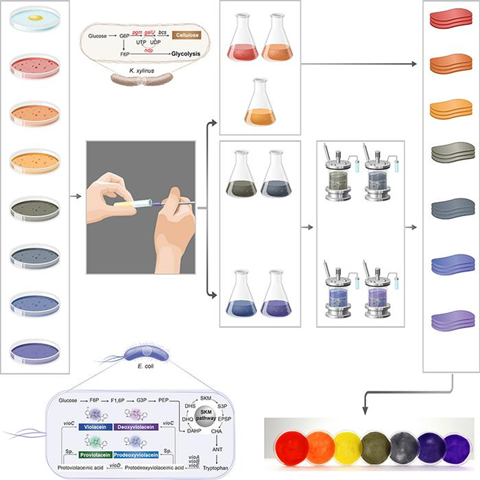A research group at KAIST has successfully developed a modular co-culture platform for the one-pot production of rainbow-colored bacterial cellulose.

The team, led by Distinguished Professor Sang Yup Lee from the Department of Chemical and Biomolecular Engineering, engineered Komagataeibacter xylinus for bacterial cellulose synthesis and Escherichia coli for natural colorants overproduction. A co-culture of these engineered strains enabled the in situ coloration of bacterial cellulose.
This research offers a versatile platform for producing living materials in multiple colors, and provides new opportunities for sustainable textiles, wearable biomaterials, and functional living materials that combine optical and structural properties beyond the reach of conventional textile technologies.
Biodegradable fabric
Bacterial cellulose is an attractive and biodegradable alternative to petroleum-derived fabrics due to its high purity, mechanical strength, and water-retention properties. However, the limited color range of bacterial cellulose, which is typically white, has limited its broader application in the textile industry, where more vibrant colored fabrics are increasingly desired.
Conventional dyeing methods rely on petroleum-based colorants and toxic reagents, creating environmental and processing challenges. These challenges have driven the demand for alternative production methods.
READ MORE: Researchers engineer a microbial platform for efficient lutein production
READ MORE: Scientists develop eco-friendly, nylon-like plastic using microorganisms
To address these issues, KAIST researchers, including Ph.D. Candidate Hengrui Zhou, Ph.D. Candidate Pingxin Lin, Professor Ki Jun Jeong, and Distinguished Professor Sang Yup Lee, combined systems metabolic engineering with co-culture strategies to develop a bio-based route that integrates bacterial cellulose formation with natural pigment synthesis, enabling the production of colored living materials in a single step without additional chemical processing.
The team’s work, entitled “One-pot production of colored bacterial cellulose,” was published in Trends in Biotechnology on November 12,2025.
One-pot production
This research details the one-pot production of multicolored bacterial cellulose using a modular co-culture platform that integrates a bacterial cellulose-overproducing K. xylinus strain with natural colorant-producing E. coli strains.
The team focused on addressing the limitations in bacterial cellulose coloration caused by environmental challenges and complex processing requirements. By employing vesicle engineering and optimizing co-culture parameters, the researchers achieved one-pot production of red, orange, yellow, green, blue, navy, and purple bacterial cellulose, eliminating the need for external dyes and toxic chemical treatments.
To enhance dyeing efficiency, E. coli strains were engineered for the overproduction and secretion of natural colorants. It was determined that the intracellular accumulation of these pigments disrupts cellular metabolism and physiology, thereby inhibiting their production. To overcome this limitation, vesicle engineering has emerged as a key strategy to mitigate these cytotoxic effects, including the induction of inner- and outer-membrane vesicles and the modulation of cell morphology, enabling the more efficient secretion of colorants and increased overall production.
The engineered E. coli strains were optimized in fed-batch fermentation, achieving record-breaking production of 16.92 ± 0.10 g/L of deoxyviolacein, 8.09 ± 0.17 g/L of violacein, 1.82 ± 0.07 g/L of proviolacein, and 936.25 ± 9.70 mg/L of prodeoxyviolacein, the highest reported titers to date for all four violacein derivatives.
Co-culture platform
A co-culture platform combining the K. xylinus with E. coli strains was further developed and optimized, enabling the in situ one-pot coloration of bacterial cellulose in vibrant green, blue, navy, and purple.
Fed-batch fermentation further improved the performance of the platform, achieving the world-first one-pot production of multicolored bacterial cellulose on a larger scale. To expand the bacterial cellulose color palette, engineered carotenoid-producing E. coli strains were incorporated, enabling the successful synthesis of red, orange, and yellow bacterial cellulose. This milestone demonstrates the potential of microbial fermentation as a sustainable alternative to petroleum-based textile processes.

“We can anticipate that this microbial cell factory-based one-pot production of rainbow-colored bacterial cellulose has the potential to replace current petroleum-based textile processes,” said Ph.D. Candidate Hengrui Zhou. “The systems metabolic engineering strategies developed in this study could be broadly applied for the production of diverse sustainable textiles, wearable biomaterials, and functional living materials that combine optical and structural properties beyond the capabilities of conventional textile technologies.
Design possibilities
He added, “This platform reduces the environmental impact while greatly expanding design possibilities. Beyond serving as a proof-of-concept, this technology offers a promising route toward scalable, eco-friendly fabrics with in situ coloration. Its modular design allows the incorporation of diverse natural colorant pathways, enabling the creation of living materials in multiple colors.”
“As demand for sustainable textiles and living materials continues to grow, we expect that the integrated biomanufacturing platform developed here will play a pivotal role in producing diverse functional biomaterials with additional design possibilities in a single step, without additional chemical processing,” explained Distinguished Professor Sang Yup Lee.
This work was supported by the Development of Next-generation Biorefinery Platform Technologies for Leading Bio-based Chemicals Industry project (2022M3J5A1056072) and the Development of Platform Technologies of Microbial Cell Factories for the Next-generation Biorefineries project (2022M3J5A1056117) from the National Research Foundation supported by the Korean Ministry of Science and ICT.
Topics
- Asia & Oceania
- Bacteria
- bacterial cellulose
- Bioengineering
- Climate Action
- co-culture platform
- colorants
- Early Career Research
- Economic Equality
- Escherichia coli
- Healthy Land
- Hengrui Zhou
- Industrial Microbiology
- Innovation News
- Ki Jun Jeong
- Komagataeibacter xylinus
- Korea Advanced Institute of Science and Technology
- Microbial Fermentation
- Pingxin Lin
- Sang Yup Lee
- Synthetic Biology
- vesicle engineering
- Young Innovators







No comments yet